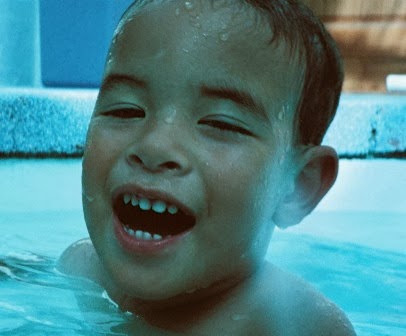We progress to orientate, learn/teach, co-ordinate in the
open swimming pool away from our ‘safe area’ on the step. We will use and
practice the breathing and bubble blowing skills, face in the water, kicking
that we learned
The relationship of trust that we developed makes this next step a simple progression
http://swimmingguidance.blogspot.com/2013/11/trust-lead-by-example.html post 15
We support the body by wrapping arms around our neck, our
elbows gently support to stabilise the hips, our hands firmly support the knees
to simulate the upbeat and the downbeat of kicking without strain on the legs
and joints which push against the resistance of the water
http://swimmingguidance.blogspot.com/2014/01/swimming-guidance-learnteach-skills_20.html post 37http://swimmingguidance.blogspot.com/2014/01/swimming-guidance-learnteach-skills_24.html post 38
We cannot ‘see’ our kicking. We stimulate big splashy kicks
by lifting the legs high and push the legs down deeply into the water to feel
the kicking action. Kick with the legs close together
We learned to ‘visualise’ what kicking looks like with
repeated practices while sitting on the step. The clear verbal explanation is
familiar and understood
http://swimmingguidance.blogspot.com/2013/12/learn-to-visualise-post-23.html
post 23
As we walk backwards in a circle, to the pupil it appears the
propulsion of their continuous rhythmic kicking creates forward movement.
Continue this routine for at least five minutes
We talk quietly, rhythmically saying ‘kick and up and down
and up and down’. We are creating feelings and sensations and actions. The body
is being supported to lie horizontally in the water. Legs only are being used
for kicking while the hands and arms learn to ‘hold on’ gently, without fear or
panic
As confidence is gained explain that ‘we will hold hands
while kicking’. Transfer to using the ‘hand
holding technique’. If it is necessary to encourage a sense of security support
the shoulders by extending one or two fingers on each hand from the position of
the ‘hand holding technique’
The legs which are no longer supported will begin to drop
down in the water. The many kicking practices will automatically start the legs
kicking to lift the body up to the surface of the water into the horizontal
position which ‘feels’ safe and familiar. Again motivate that legs be lifted
high up above the water to kick back down to make big splashy kicks. This
practice ensures that the kick is always at the surface of the water where it
lifts the body up to the surface of the water
After a few minutes explain that you will let go of the
shoulders so that ‘the hands only are being held’. Though the elbows are bent
always keep the hands shoulder width apart. This position is correct for use of
the correct muscles, for the straight line of the arms to reach and stretch
forward for all future water and swimming skills learned. Another of the many
skills we teach that is not ‘the obvious
From the position of either supporting the shoulders or not
we can motivate, exactly as we have many times over whilst
learning/teaching/practicing in the ‘safe area’, the ‘bubble blowing’ routine
The ‘hand holding
technique’ in its feel of familiarity and trust is the pivot on which we
learn/teach to turn onto the back. Both hands adjust slightly to accommodate
the change in body position from front to back to re-adjust when turning back
onto the tummy. We experienced the ‘hand adjustment’ when learning to pick up
toys on the step and when diving down to pick up toys then swimming back to the
step
Gently, quietly explain that we are going to attempt a new
skill. Count rhythmically ‘and one and two and three’, slowly roll the body
over, support the shoulders under the water with the crossed over arm
Kicking has been continuous throughout the roll. Continue
kicking practices for a while on the back so that this progressive skill
becomes familiar. Count rhythmically ‘and one and two and three’ slowly roll
the body over onto the tummy. We are learning without ‘teaching the obvious’ to
roll in the water
PROGRESSIVE SKILLS –
©
The head is up. ‘Take a big breath’ before rolling onto
the back. Breathe out. ‘Take a big breath’ then roll onto the tummy. Blow
bubbles into the water
©
‘Take a big breath’. Put the face in the water, blow
bubbles, roll onto the back, take a big breath
©
While on the back, ‘take a big breath’, roll onto the
tummy, ‘blow bubbles’ then lift the head up to take a breath










